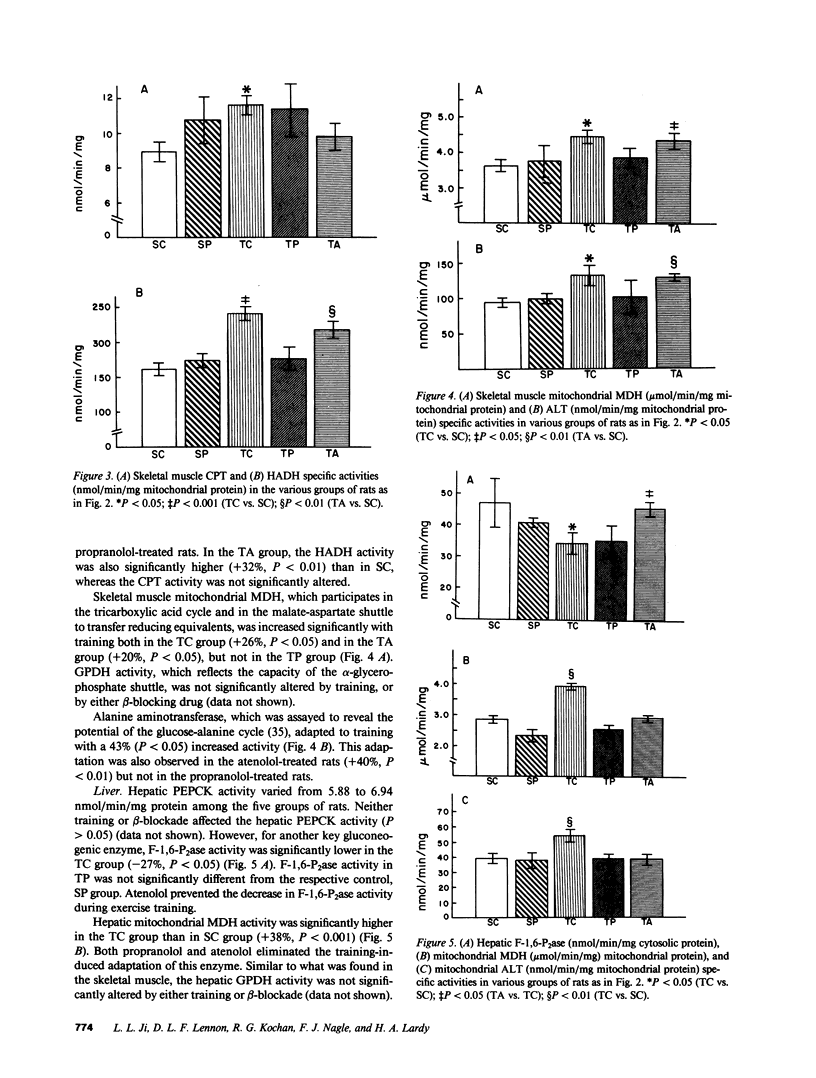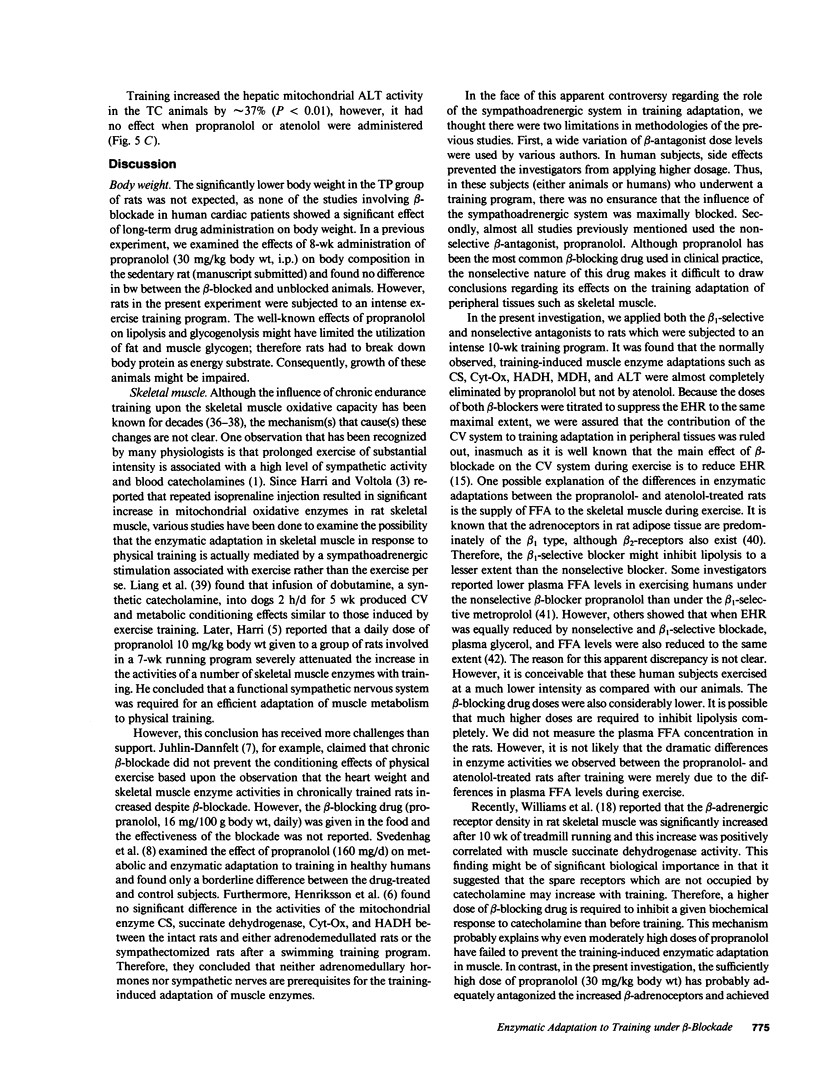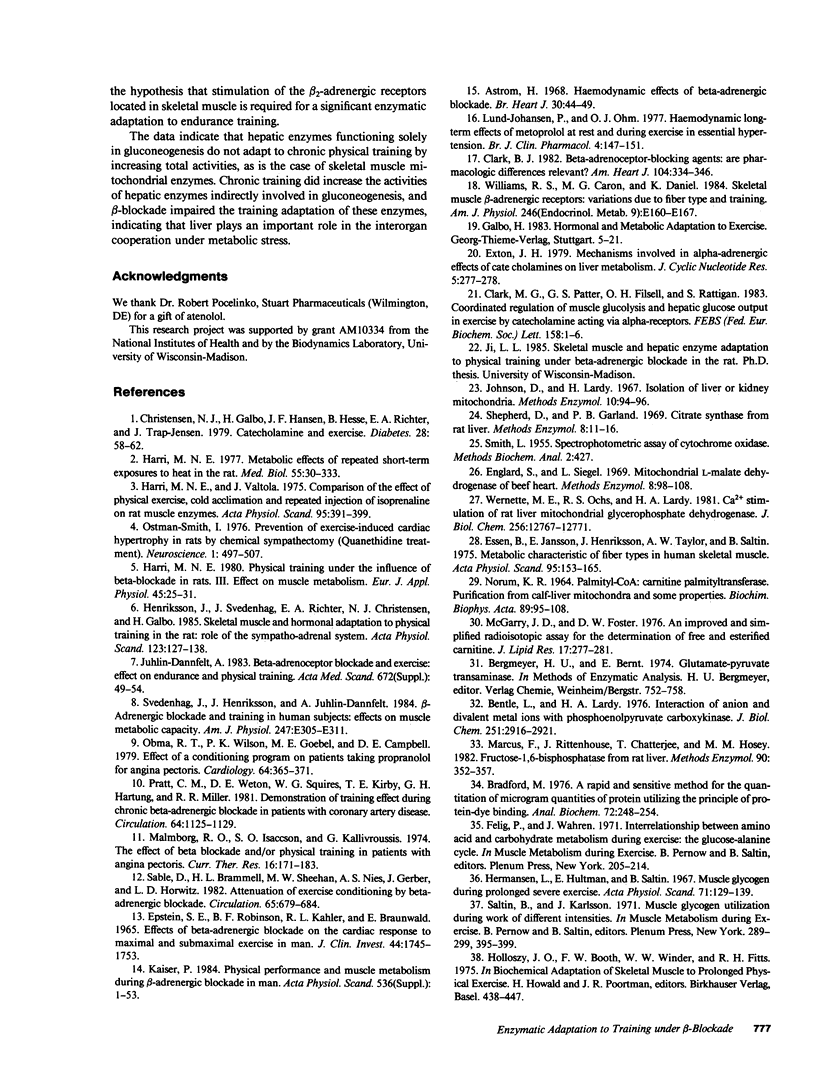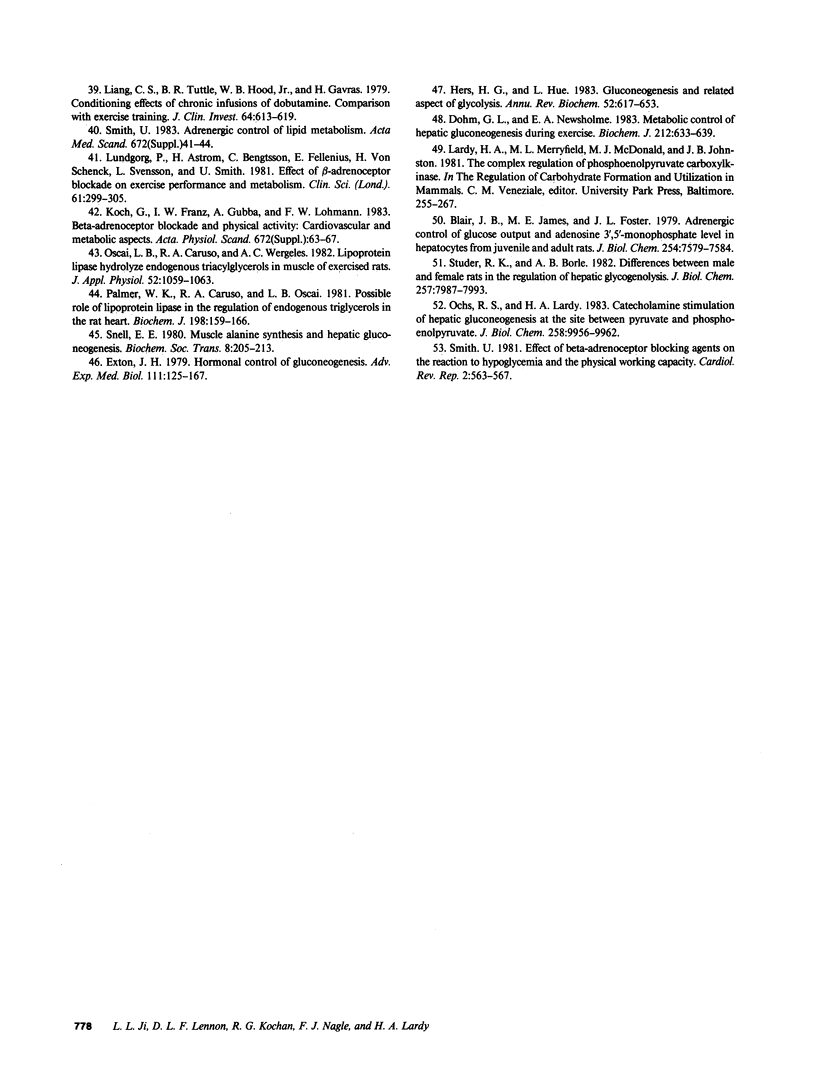Abstract
Nonselective and beta 1-selective adrenergic antagonists were tested for their effects on enzymatic adaptation to exercise training in rats as follows: trained + placebo (TC); trained + propranolol (TP); trained + atenolol (TA); and corresponding sedentary groups, SC and SP. Trained rats ran 1 h/d at 26.8 m/min, 15% grade, 5 d/wk, 10 wk. Both beta-antagonists were given at doses that decreased exercise heart rates by 25%. Training increased skeletal muscle citrate synthase, cytochrome c oxidase (Cyt-Ox), carnitine palmitoyltransferase (CPT), beta-hydroxyacyl coenzyme A dehydrogenase, mitochondrial malate dehydrogenase (MDH), and alanine aminotransferase (ALT) activities significantly in the TC group, but not in TP. These enzyme activities, except Cyt-Ox and CPT, were also significantly increased in TA. Hepatic phosphoenolpyruvate carboxykinase activity did not alter with training or beta-blockade. Fructose 1,6-bisphosphatase activity was lower in TC than in SC, but unchanged in TP or TA. Hepatic mitochondrial MDH and ALT activities increased with training only in TC. It is concluded that beta 2-adrenergic mechanisms play an essential role in the training-induced enzymatic adaptation in skeletal muscle.
Full text
PDF







Selected References
These references are in PubMed. This may not be the complete list of references from this article.
- Aström H. Haemodynamic effects of beta-adrenergic blockade. Br Heart J. 1968 Jan;30(1):44–49. doi: 10.1136/hrt.30.1.44. [DOI] [PMC free article] [PubMed] [Google Scholar]
- Bentle L. A., Lardy H. A. Interaction of anions and divalent metal ions with phosphoenolpyruvate carboxykinase. J Biol Chem. 1976 May 25;251(10):2916–2921. [PubMed] [Google Scholar]
- Blair J. B., James M. E., Foster J. L. Adrenergic control of glucose output and adenosine 3':5'-monophosphate levels in hepatocytes from juvenile and adult rats. J Biol Chem. 1979 Aug 25;254(16):7579–7584. [PubMed] [Google Scholar]
- Bradford M. M. A rapid and sensitive method for the quantitation of microgram quantities of protein utilizing the principle of protein-dye binding. Anal Biochem. 1976 May 7;72:248–254. doi: 10.1006/abio.1976.9999. [DOI] [PubMed] [Google Scholar]
- Christensen N. J., Galbo H., Hansen J. F., Hesse B., Richter E. A., Trap-Jensen J. Catecholamines and exercise. Diabetes. 1979 Jan;28 (Suppl 1):58–62. doi: 10.2337/diab.28.1.s58. [DOI] [PubMed] [Google Scholar]
- Clark B. J. Beta-adrenoceptor-blocking agents: are pharmacologic differences relevant? Am Heart J. 1982 Aug;104(2 Pt 2):334–346. doi: 10.1016/0002-8703(82)90124-7. [DOI] [PubMed] [Google Scholar]
- Clark M. G., Patten G. S., Filsell O. H., Rattigan S. Co-ordinated regulation of muscle glycolysis and hepatic glucose output in exercise by catecholamines acting via alpha-receptors. FEBS Lett. 1983 Jul 11;158(1):1–6. doi: 10.1016/0014-5793(83)80664-4. [DOI] [PubMed] [Google Scholar]
- Dohm G. L., Newsholme E. A. Metabolic control of hepatic gluconeogenesis during exercise. Biochem J. 1983 Jun 15;212(3):633–639. doi: 10.1042/bj2120633. [DOI] [PMC free article] [PubMed] [Google Scholar]
- Epstein S., Robinson B. F., Kahler R. L., Braunwald E. Effects of beta-adrenergic blockade on the cardiac response to maximal and submaximal exercise in man. J Clin Invest. 1965 Nov;44(11):1745–1753. doi: 10.1172/JCI105282. [DOI] [PMC free article] [PubMed] [Google Scholar]
- Essén B., Jansson E., Henriksson J., Taylor A. W., Saltin B. Metabolic characteristics of fibre types in human skeletal muscle. Acta Physiol Scand. 1975 Oct;95(2):153–165. doi: 10.1111/j.1748-1716.1975.tb10038.x. [DOI] [PubMed] [Google Scholar]
- Exton J. H. Hormonal control of gluconeogenesis. Adv Exp Med Biol. 1979;111:125–167. doi: 10.1007/978-1-4757-0734-2_7. [DOI] [PubMed] [Google Scholar]
- Exton J. H. Mechanisms involved in alpha-adrenergic effects of catecholamines on liver metabolism. J Cyclic Nucleotide Res. 1979;5(4):277–287. [PubMed] [Google Scholar]
- Harri M. N. Metabolic effects of repeated short-term exposures to heat in the rat. Med Biol. 1977 Dec;55(6):330–333. [PubMed] [Google Scholar]
- Harri M. N. Physical training under the influence of beta-blockade in rats. III. Effects on muscular metabolism. Eur J Appl Physiol Occup Physiol. 1980;45(1):25–31. doi: 10.1007/BF00421198. [DOI] [PubMed] [Google Scholar]
- Harri M. N., Valtola J. Comparison of the effects of physical exercise, cold acclimation and repeated injections of isoprenaline on rat muscle enzymes. Acta Physiol Scand. 1975 Dec;95(4):391–399. doi: 10.1111/j.1748-1716.1975.tb10066.x. [DOI] [PubMed] [Google Scholar]
- Henriksson J., Svedenhag J., Richter E. A., Christensen N. J., Galbo H. Skeletal muscle and hormonal adaptation to physical training in the rat: role of the sympatho-adrenal system. Acta Physiol Scand. 1985 Feb;123(2):127–138. doi: 10.1111/j.1748-1716.1985.tb07569.x. [DOI] [PubMed] [Google Scholar]
- Hermansen L., Hultman E., Saltin B. Muscle glycogen during prolonged severe exercise. Acta Physiol Scand. 1967 Oct-Nov;71(2):129–139. doi: 10.1111/j.1748-1716.1967.tb03719.x. [DOI] [PubMed] [Google Scholar]
- Hers H. G., Hue L. Gluconeogenesis and related aspects of glycolysis. Annu Rev Biochem. 1983;52:617–653. doi: 10.1146/annurev.bi.52.070183.003153. [DOI] [PubMed] [Google Scholar]
- Juhlin-Dannfelt A. beta-Adrenoceptor blockade and exercise: effects on endurance and physical training. Acta Med Scand Suppl. 1983;672:49–54. doi: 10.1111/j.0954-6820.1983.tb01613.x. [DOI] [PubMed] [Google Scholar]
- Kaiser P. Physical performance and muscle metabolism during beta-adrenergic blockade in man. Acta Physiol Scand Suppl. 1984;536:1–53. [PubMed] [Google Scholar]
- Liang C., Tuttle R. R., Hood W. B., Jr, Gavras H. Conditioning effects of chronic infusions of dobutamine. Comparison with exercise training. J Clin Invest. 1979 Aug;64(2):613–619. doi: 10.1172/JCI109501. [DOI] [PMC free article] [PubMed] [Google Scholar]
- Lund-Johansen P., Ohm O. J. Haemodynamic long-term effects of metoprolol at rest and during exercise in essential hypertension. Br J Clin Pharmacol. 1977 Apr;4(2):147–151. doi: 10.1111/j.1365-2125.1977.tb00686.x. [DOI] [PMC free article] [PubMed] [Google Scholar]
- Lundborg P., Aström H., Bengtsson C., Fellenius E., von Schenck H., Svensson L., Smith U. Effect of beta-adrenoceptor blockade on exercise performance and metabolism. Clin Sci (Lond) 1981 Sep;61(3):299–305. doi: 10.1042/cs0610299. [DOI] [PubMed] [Google Scholar]
- Malmborg R. O., Isacsson S. O., Kallivroussis G. The effect of beta blockade and-or physical training in patients with angina pectoris. Curr Ther Res Clin Exp. 1974 Mar;16(3):171–183. [PubMed] [Google Scholar]
- Marcus F., Rittenhouse J., Chatterjee T., Hosey M. M. Fructose-1,6-bisphosphatase from rat liver. Methods Enzymol. 1982;90(Pt E):352–357. doi: 10.1016/s0076-6879(82)90155-0. [DOI] [PubMed] [Google Scholar]
- McGarry J. D., Foster D. W. An improved and simplified radioisotopic assay for the determination of free and esterified carnitine. J Lipid Res. 1976 May;17(3):277–281. [PubMed] [Google Scholar]
- NORUM K. R. PALMITYL-COA:CARNITINE PALMITYLTRANSFERASE. PURIFICATION FROM CALF-LIVER MITOCHONDRIA AND SOME PROPERTIES OF THE ENZYME. Biochim Biophys Acta. 1964 Jul 8;89:95–108. [PubMed] [Google Scholar]
- Obma R. T., Wilson P. K., Goebel M. E., Campbell D. E. Effect of a conditioning program in patients taking propranolol for angina pectoris. Cardiology. 1979;64(6):365–371. doi: 10.1159/000170634. [DOI] [PubMed] [Google Scholar]
- Ochs R. S., Lardy H. A. Catecholamine stimulation of hepatic gluconeogenesis at the site between pyruvate and phosphoenolpyruvate. J Biol Chem. 1983 Aug 25;258(16):9956–9962. [PubMed] [Google Scholar]
- Oscai L. B., Caruso R. A., Wergeles A. C. Lipoprotein lipase hydrolyzes endogenous triacylglycerols in muscle of exercised rats. J Appl Physiol Respir Environ Exerc Physiol. 1982 Apr;52(4):1059–1063. doi: 10.1152/jappl.1982.52.4.1059. [DOI] [PubMed] [Google Scholar]
- Ostman-Smith I. Prevention of exercise-induced cardiac hypertrophy in rats by chemical sympathectomy (guanethidine treatment). Neuroscience. 1976 Dec;1(6):497–507. doi: 10.1016/0306-4522(76)90102-0. [DOI] [PubMed] [Google Scholar]
- Palmer W. K., Caruso R. A., Oscai L. B. Possible role of lipoprotein lipase in the regulation of endogenous triacylglycerols in the rat heart. Biochem J. 1981 Jul 15;198(1):159–166. doi: 10.1042/bj1980159. [DOI] [PMC free article] [PubMed] [Google Scholar]
- Pratt C. M., Welton D. E., Squires W. G., Jr, Kirby T. E., Hartung G. M., Miller R. R. Demonstration of training effect during chronic beta-adrenergic blockade in patients with coronary artery disease. Circulation. 1981 Dec;64(6):1125–1129. doi: 10.1161/01.cir.64.6.1125. [DOI] [PubMed] [Google Scholar]
- SMITH L. Spectrophotometric assay of cytochrome c oxidase. Methods Biochem Anal. 1955;2:427–434. doi: 10.1002/9780470110188.ch13. [DOI] [PubMed] [Google Scholar]
- Sable D. L., Brammell H. L., Sheehan M. W., Nies A. S., Gerber J., Horwitz L. D. Attenuation of exercise conditioning by beta-adrenergic blockade. Circulation. 1982 Apr;65(4):679–684. doi: 10.1161/01.cir.65.4.679. [DOI] [PubMed] [Google Scholar]
- Snell K. Muscle alanine synthesis and hepatic gluconeogenesis. Biochem Soc Trans. 1980 Apr;8(2):205–213. doi: 10.1042/bst0080205. [DOI] [PubMed] [Google Scholar]
- Studer R. K., Borle A. B. Differences between male and female rats in the regulation of hepatic glycogenolysis. The relative role of calcium and cAMP in phosphorylase activation by catecholamines. J Biol Chem. 1982 Jul 25;257(14):7987–7993. [PubMed] [Google Scholar]
- Svedenhag J., Henriksson J., Juhlin-Dannfelt A. Beta-adrenergic blockade and training in human subjects: effects on muscle metabolic capacity. Am J Physiol. 1984 Sep;247(3 Pt 1):E305–E311. doi: 10.1152/ajpendo.1984.247.3.E305. [DOI] [PubMed] [Google Scholar]
- Wernette M. E., Ochs R. S., Lardy H. A. Ca2+ stimulation of rat liver mitochondrial glycerophosphate dehydrogenase. J Biol Chem. 1981 Dec 25;256(24):12767–12771. [PubMed] [Google Scholar]
- Williams R. S., Caron M. G., Daniel K. Skeletal muscle beta-adrenergic receptors: variations due to fiber type and training. Am J Physiol. 1984 Feb;246(2 Pt 1):E160–E167. doi: 10.1152/ajpendo.1984.246.2.E160. [DOI] [PubMed] [Google Scholar]


